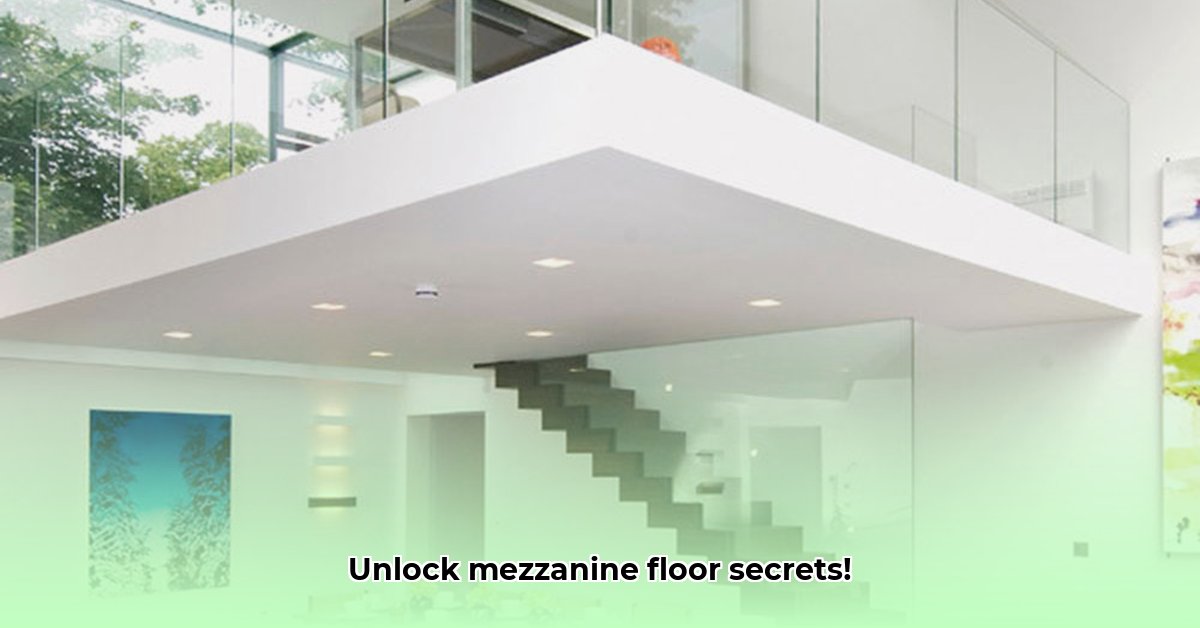Maximize your building’s potential without the hassle of expensive expansions. This guide provides a comprehensive overview of mezzanine floors, covering their definition, types, construction, cost considerations, and maintenance. For more in-depth information, check out this helpful guide. Whether you’re a business owner, contractor, or simply curious, this guide will equip you with the knowledge to understand mezzanine floors and determine if they are the right fit for your needs. From boosting storage capacity to creating additional office space, a mezzanine floor can be an efficient way to optimize usable area and enhance your business operations.
Decoding Mezzanine Floors: Definition and Applications
A mezzanine floor is an intermediate level or platform built within a building, typically between the main floor and the ceiling. Functioning like a partial second floor, it’s a strategic approach to gaining extra space without the cost and complexity of adding an entire story. Mezzanines are commonly used in commercial, industrial, and even residential settings to optimize existing space for offices, storage, manufacturing, retail displays, or recreational areas.
The Advantages of Mezzanine Structures
Mezzanine floors offer a range of benefits, making them a popular choice for businesses and property owners looking to maximize their space:
- Cost-Effectiveness: Compared to building expansions or relocating to larger premises, mezzanines offer a more affordable solution for increasing usable floor area.
- Space Optimization: Mezzanines effectively utilize vertical space, allowing businesses to maximize their existing footprint without expanding outwards.
- Versatility: Mezzanines can be customized to suit a variety of needs, from storage and office space to retail displays and production areas.
- Flexibility: Many mezzanine systems are modular and can be easily reconfigured or relocated as business needs evolve.
- Minimal Disruption: Mezzanine installations typically involve less disruption to ongoing operations compared to traditional construction projects.
Exploring Mezzanine Floor Types
Mezzanine floors come in various types, each suited to specific applications and structural requirements:
- Structural Steel Mezzanines: These are the most common type, consisting of steel beams, columns, and decking. They offer high strength and durability, making them suitable for industrial and commercial applications with heavy load requirements.
- Modular Mezzanines: These pre-engineered systems offer flexibility and ease of installation. They are often used in retail spaces, offices, and warehouses where space needs may change frequently.
- Rack-Supported Mezzanines: These mezzanines utilize existing pallet racking systems as support structures, providing a cost-effective solution for expanding storage capacity in warehouses and distribution centers.
- Concrete Mezzanines: Primarily for high-capacity needs, requiring specialized skill, these provide minimal noise transmission and increased fire resistance.
When selecting a mezzanine type, consider factors such as load requirements, space constraints, budget, and aesthetic preferences.
Step-by-Step Guide to Mezzanine Floor Construction
Constructing a mezzanine floor involves a systematic process that requires careful planning and execution:
- Define Your Needs: Clearly define the purpose of the mezzanine, including its intended use, dimensions, and load-bearing requirements. This will guide the design and material selection process.
- Evaluate Existing Space: Conduct a thorough assessment of the building’s structural integrity, ceiling height, floor load capacity, and accessibility. A professional structural engineer can help determine the feasibility of a mezzanine installation and identify any potential challenges.
- Design and Engineering: Develop detailed plans and specifications for the mezzanine, ensuring compliance with local building codes, safety regulations, and accessibility standards. Consider factors such as stair locations, handrail requirements, and fire protection measures.
- Secure Permits: Obtain all necessary building permits and approvals from local authorities before commencing construction. This may involve submitting detailed plans, structural calculations, and other documentation.
- Construction and Installation: Hire experienced contractors and construction teams to install the mezzanine according to the approved plans and specifications. Ensure that all work is performed in compliance with safety regulations and industry best practices.
- Inspection and Compliance: Conduct thorough inspections throughout the construction process to ensure that the mezzanine meets all applicable building codes, safety standards, and design requirements. Address any deficiencies or issues promptly.
- Ongoing Maintenance: Implement a regular maintenance program to inspect and maintain the mezzanine, ensuring its structural integrity, safety, and functionality over time. Address any repairs or maintenance issues promptly to prevent further damage or safety hazards.
Prioritizing Safety: Regulations and Key Considerations
Safety is essential when designing, constructing, and using mezzanine floors. Adhere to local building codes and safety regulations, including those related to:
- Load Capacity: Ensure that the mezzanine is designed and constructed to support the intended loads, including the weight of people, equipment, and stored materials.
- Stairways and Access: Provide safe and accessible stairways, ramps, or lifts for accessing the mezzanine, complying with accessibility standards such as the Americans with Disabilities Act (ADA).
- Guardrails and Handrails: Install guardrails and handrails along the edges of the mezzanine and stairways to prevent falls and ensure the safety of occupants.
- Fire Safety: Implement fire protection measures such as fire-resistant materials, sprinkler systems, smoke detectors, and emergency exits to minimize the risk of fire and ensure safe evacuation in the event of an emergency.
Consult with qualified professionals, such as structural engineers, architects, and fire safety experts, to ensure compliance with all applicable regulations and safety standards.
Reducing Costs While Maximizing Mezzanine Floor Space
Mezzanine floors offer a cost-effective way to expand usable space, but careful planning and strategic decision-making can help minimize expenses.
Strategic Planning for Cost Savings
- Accurate Measurements: Precise measurements of the available space are crucial to avoid material waste and design errors.
- Optimized Space Utilization: Maximize the usable area of the mezzanine by carefully considering the layout, access points, and storage solutions.
- Strategic Access Point Placement: Position stairways, lifts, or ramps strategically to minimize wasted space and ensure efficient traffic flow.
Material Selection: Balancing Cost and Durability
- Steel: Known for its strength and durability, steel is a popular choice for mezzanine construction. However, it can be more expensive than other materials.
- Wood: Wood is a cost-effective option for lighter applications, but it may require additional fire protection measures.
- Concrete: Concrete mezzanine floors are durable but can be expensive and require structural modifications.
- Hybrid Approaches: Combining different materials can balance cost and functionality. For example, using steel for the primary structure and wood for the decking can provide a cost-effective solution.
Simplicity in Design: Key to Reducing Costs
- Simple Shapes: Opting for simple shapes and designs can reduce construction complexity and material costs.
- Optimized Column Grids: Strategic placement of support columns can minimize steel usage and reduce overall costs.
- Prefabricated Components: Using prefabricated components can streamline installation and lower labor expenses.
- Professional Expertise: Consulting with a structural engineer can ensure that the design is optimized for cost-effectiveness and compliance with building codes.
Enhancing Retail Space: Installing Mezzanine Floors for Better Customer Experience
Mezzanine floors can transform retail spaces, creating more room for product displays, customer seating, or even additional sales areas.
Retail Mezzanine Benefits
- Increased Retail Space: Mezzanine floors can double or triple usable retail space, allowing businesses to showcase more products and serve more customers.
- Improved Product Displays: Mezzanines offer opportunities to create visually appealing product displays and dedicated areas for showcasing specific merchandise.
- Better Customer Flow: Strategically designed mezzanines can improve customer flow and create a more engaging shopping experience.
- Cost-Effective Expansion: Installing a mezzanine floor is often more cost-effective than expanding the building’s footprint or relocating to a larger space.
Mezzanine Installation
- Site Assessment: Evaluate the structural integrity of the building and the available space for a mezzanine installation.
- Design & Permits: Develop compliant plans that meet aesthetic and functional needs, and obtain the necessary permits.
- Material Selection: Choose materials that align with the store’s aesthetic and functional requirements, such as flooring, lighting, and railings.
- Contractor Selection: Hire experienced contractors with a proven track record of successful mezzanine installations in retail spaces.
- Installation: Adhere to strict safety protocols and minimize disruption to ongoing business operations during the installation process.
Design Considerations
- Lighting: Incorporate ample lighting to create a bright and inviting atmosphere on the mezzanine level.
- Accessibility (ADA Compliance): Ensure that the mezzanine is accessible to customers with disabilities by providing ramps, lifts, or accessible stairways.
- Fire Safety: Implement fire safety measures such as fire-resistant materials, sprinkler systems, and emergency exits to protect customers and employees in the event of a fire.
- Brand Aesthetics: Design the mezzanine to align with the store’s overall branding and create a cohesive customer experience.
Potential Challenges and Solutions
| Challenge | Mitigation Strategy |
|---|---|
| Insufficient Headroom | Carefully assess the existing ceiling height before committing to a mezzanine installation. Consider lowering the main floor. |
| Increased Costs | Obtain multiple quotes from contractors to compare pricing and value. Explore cost-effective materials and design options. |
| Complex Installation | Choose an experienced contractor |
- Glass Mosaic Kitchen Backsplash: Add Shimmer and Style - December 9, 2025
- Glass Mosaic Backsplash: A Stylish Upgrade For Your Kitchen - December 8, 2025
- Glass Tile Shower Ideas to Create a Stunning Bathroom Space - December 7, 2025









